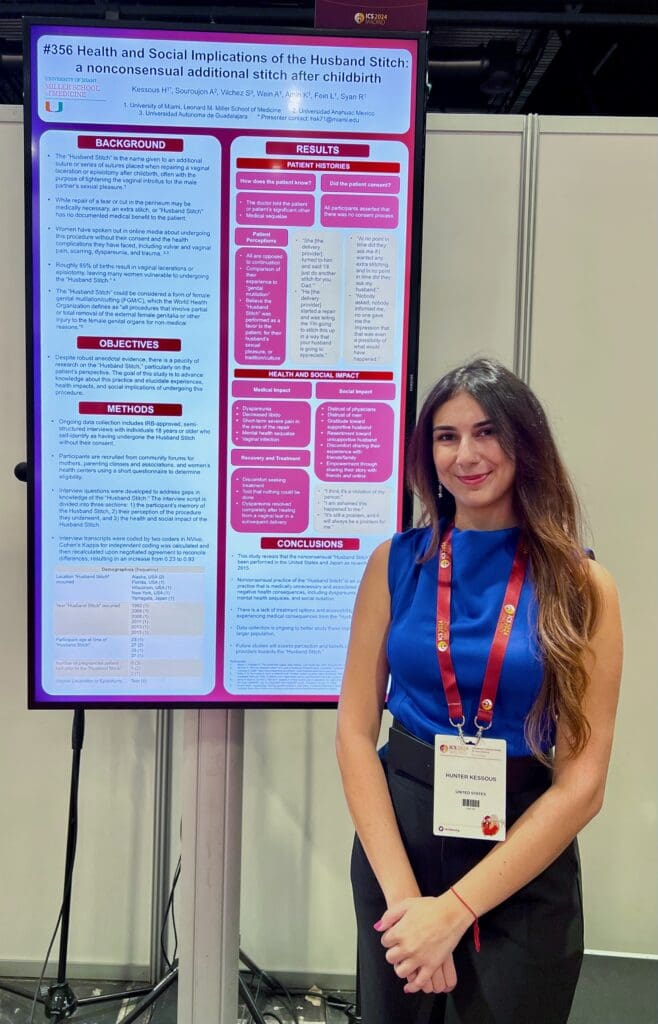The “Husband Stitch” as an Underrecognized Form of Female Genital Mutilation/Cutting
Posted: November 13. 2024
by Hunter Kessous
The “Husband Stitch” is the name given to the medical practice of placing an extra stitch during vaginal repair during childbirth. The presumed purpose of this procedure is to tighten the vaginal opening to increase sexual pleasure for a male partner. Vaginal tearing requiring stitches to repair the injury is common during childbirth, but the placement of an additional stitch is medically unnecessary. Women have spoken out in the media and lawsuits about undergoing the “Husband Stitch” without their consent. Despite this anecdotal evidence, the “Husband Stitch” is often thought to be a myth because there has been no medical research on the subject to validate the stories of women who have undergone the “Husband Stitch” without their consent. Finally, however, this is starting to change.

I am a second-year medical student at the University of Miami Miller School of Medicine working with the guidance of urologist and urogynecologist Dr. Raveen Syan to create the first medical literature on the “Husband Stitch.” This past year, we have been conducting interviews with women who underwent the “Husband Stitch” without their consent. This research is ongoing, however thus far I have had the opportunity to speak with five brave women about their birth experience. Our preliminary findings from these conversations reveal that the “Husband Stitch” has been practiced in the United States as recently as 2015 as well as in Japan in 2008. The language that their obstetricians used to describe the procedure made it clear to two of the women that their physicians placed an additional stitch following delivery as a “favor” to their husbands. All five of the women experienced health complications following the “Husband Stitch,” including short-term pain around the stitch and long-term pain during sex. Our findings signal serious health consequences of the “Husband Stitch” and a lack of treatment options. All participants are opposed to the continuation of the “Husband Stitch” and report feelings of shame and helplessness surrounding their experience.
During the interviews, two of the women compared their experience of the “Husband Stitch” to female genital mutilation/cutting (FGM/C). One participant eloquently shared, “I know that in other countries and religions that are restrictive, that they do genital mutilation. And it’s not right. And what happened to me was not nearly as extreme, but it was still something I never thought could happen to me because I was in America.” Her sentiment echoes a common misconception about FGM/C– that it is not an American problem. However, I propose that the “Husband Stitch” can and should be considered a form of FGM/C. The World Health Organization defines FGM/C as “all procedures that involve partial or total removal of the external female genitalia or other injury to the female genital organs for non-medical reasons.” Like FGM/C, the “Husband Stitch” is likely a medically unnecessary procedure on female genitalia associated with negative health and social consequences. Type 3 FGM/C, also known as infibulation, is the narrowing of the vaginal opening through the creation of a covering seal. While the “Husband Stitch” does not involve use of the labia to form a seal, it has a similar impact in narrowing the vaginal opening and a common complication of pain during sex. As we continue to learn more about the “Husband Stitch” through research, I urge organizations working to end FGM/C to include advocacy against the “Husband Stitch” in their work.
For more information about this research, you can view an abstract and research poster with the preliminary findings here. I had the opportunity to present this abstract at the International Continence Society 2024 Conference in Madrid, Spain, where I was fortunate to discover that the medical community cares about this issue. Our research is ongoing to further study the “Husband
Stitch” and its implications.

Hunter Kessous is a second-year candidate for a combined MD/MPH degree at the University of Miami Miller School of Medicine (UMMSOM) with nearly 8 years of non-profit and research experience in gender-based violence, particularly female genital mutilation/cutting (FGM/C). She is a member of The U.S. End FGM/C Network and volunteer with Sahiyo. Her current research aims to elucidate the health and societal impacts of undergoing an unwanted additional stitch following a tear or episiotomy in childbirth, also known as the Husband Stitch.
